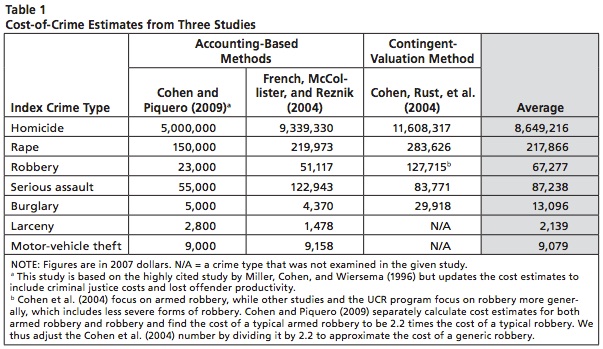
Weekly Roundup: From Greek Games to Tennis Matches
June 13, 2015
Less Choice Fatigue at Whole Foods
June 15, 2015In NYC on sunny days, drivers used to turn on their wipers at traffic lights. The reason was the squeegee men.
Expecting several dollars, these squeegee men had their squeegee sponges for wiping car windows. To avoid the wipe (and a dirtier window after they finished), you could give them a dollar or two before they started or you could turn on your wipers.

The Squeegee
Where are we going? To deciding which crimes are worth municipal spending.
Crime Costs
Knowing how much crime costs can help us decide how much to spend. We can use three basic approaches to calculate cost.
- Accounting Valuation: The first is a numbers approach. Quantifying the cost of a crime, the accounting perspective decomposes crime spending and then gives a dollar value to each part like property loss, court costs, medical costs. For homicide that would mean giving a life a price tag, estimating the value of the victim’s and the offender’s productivity, looking at the amount spent on criminal justice, counting the relevant medical and property losses.
- Contingent Valuation: Much less tangible than accounting, the contingent look at costs takes us to willingness-to-pay. The people in these studies are given survey questions through which they indicate how much, for example, they would be willing to pay in extra taxes for a decrease in a crime rate. Because the contingent approach touches attitudes, scientists believe it can tell more than the accounting method about true cost.
- Hedonic Valuation: Here we have the spotlight on where we live. Researchers who determine the cost of crime through hedonic valuation look at how crime affects neighborhood characteristics through market transactions. One focus of the hedonic approach is home prices. It has been estimated that prices drop 4 percent in neighborhoods within .1 mile of where a sex offender lives.
For the following table, the accounting and contingent approaches were used to figure out the cost per crime. The numbers display how much it costs each time the crime is committed.

From: Rand Corporation
To get a better idea of how much spending crime takes from municipal budgets, the following table provides the picture. Rand points out that they think the numbers are low. (GMP is Gross Municipal Output–the city equivalent of the GDP.)

From: Rand Corporation
Our Bottom Line: Municipal Spending
The cost of crime takes us to the convergence of two basic economic ideas: scarcity and tradeoffs. To control crime, municipalities have to choose among scarce resources. And every time they choose, their cost requires a sacrificed alternative.
So when NYC had to decide what to do about the squeegee men, it was really about scarce municipal resources and the cost for government, victims and society.
![econlifelogotrademarkedwebsitelogo[1]](/wp-content/uploads/2024/05/econlifelogotrademarkedwebsitelogo1.png#100878)




